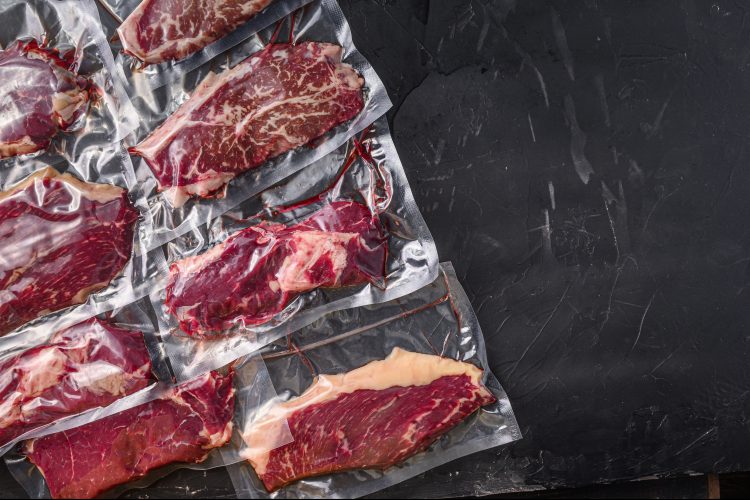The 10-day VP/MAP rule
- Like
- Digg
- Del
- Tumblr
- VKontakte
- Buffer
- Love This
- Odnoklassniki
- Meneame
- Blogger
- Amazon
- Yahoo Mail
- Gmail
- AOL
- Newsvine
- HackerNews
- Evernote
- MySpace
- Mail.ru
- Viadeo
- Line
- Comments
- Yummly
- SMS
- Viber
- Telegram
- Subscribe
- Skype
- Facebook Messenger
- Kakao
- LiveJournal
- Yammer
- Edgar
- Fintel
- Mix
- Instapaper
- Copy Link
Posted: 10 December 2020 | David Lindars | No comments yet
In an article written before today’s announcement on VP/MAP from the FSA, David Lindars from the BMPA explains why the UK regulation needed a change…


On 8 December New Food issue 6 2020 went to press. At the time of writing this article, the UK Food Standards Agency (FSA) Vacuum Packed/Modified Atmosphere Packed (VP/MAP) Guidance (FSA, 2017) restricted the shelf life of VP/MAP foods (including fresh meat) held at temperatures between 3 and 8°C to 10 days, unless there are suitable grounds to extend this period.
In this piece (taken from Issue 6 2020), we hear from David Lindars, Technical Operations Director at the British Meat Processing Association (BMPA), on why this 10-day rule needs a review. Since he penned this article, new regulation has been announced from the Food Standards Agency (FSA). From now on, food business operators can choose a safe shelf-life for these specific products in line with their existing food safety management systems, in the same way they already do for other types of food. More details on the revised rules can be found here.
Despite the change in regulation, the below article provides further context on why this update was so sorely needed…
The practice of ‘skin packing’ a meat product to a tray is considered a version of vacuum packing and is growing in popularity in the UK. Skin packing also lends itself to the addition of garnishes, which carry an inherent microbiological risk. Therefore, as meat is unlikely to achieve any of the controlling factors that might be considered to extend freshness, it is deemed that these products should not be given a shelf life of longer than 10 days, according to current guidance. To extend this established shelf life, a series of tests must be carried out on each product line to prove its safety beyond 10 days.
The situation is very different in practice. Currently, the industry applies a chilled shelf life of two to three weeks to retail packs. The incidence of Clostridium botulinum poisoning associated with commercially produced fresh meat in the UK is zero, despite the lack of controlling factors.
Clostridium botulinum and VP/MAP chilled foods
In January 2019, a report was published by the British Meat Processors Association (BMPA) and Meat and Livestock Australia (MLA) as an open access document. This was then peer reviewed and published in April 2020, also open access. The BMPA believes that this new peer-reviewed scientific evidence represents a comprehensive piece of new research. There is considerable consumption of VP/MAP products globally with no evidence of deaths resulting from packs with a shelf life of more than 10 days. Exposure assessments (number of packs sold under the same conditions with no illness) can contribute to due diligence; given that 100 million to one billion packs were sold without illness, the extended shelf life was considered safe for C. botulinum.
Hygiene standards for production of VP/MAP red meat have been vastly improved over recent years and are still being improved today. The UK has an excellent food safety record with all foods and that is something we should be proud of thanks to the highly trained people we have managing the supply chains and producing our food. It is worth noting that red meat businesses can quote, as stated in the consortium risk assessment report, that there has been no reported association with such foodborne illness and retail packed fresh meat, with sales of over 10 billion packs of beef, pork and lamb sold in the UK between 1999 and 2017 as acceptable evidence in risk assessment terms.
The BMPA met with the Director of Policy at the FSA to discuss the way forward with respect to the review of the current 2017 guidance for the safety and shelf life of vacuum- and modified atmosphere-packed chilled foods as relating to nonproteolytic C. botulinum. This guidance is applicable to all raw and ready-to-eat VP or MAP chilled foods.

At that meeting in April 2020, a review group, jointly chaired by the BMPA and FSA, was established. The group is currently pulling together a risk management dossier for the regulators’ code, which will form the governance process for the risk management analysis. Part of this formal review by the FSA will require a consultation period of the current guidance (published 2017 and available on FSA website). It is worth noting that no other EU country applies a maximum shelf life of 10 days to fresh meat, and we are not aware of any other country in the world that does either. The group is made up of scientists, industry, regulators, trade bodies and risk management professionals. The 1992 Advisory Committee on the Microbiological Safety of Food (ACMSF) report on vacuum and MAP and associated processes on which the guidance is based was published 28 years ago.
What is very clear from all the research that has been carried out by industry in the form of risk assessments and challenge testing, is that it is very difficult for nonproteolytic C. botulinum to grow under normal conditions of between 3°C and 8°C. If you walk around a supermarket today, you will see red meat on sale with a greater than 10-day shelf life. This is because challenge testing and risk analysis has been carried out on their products’ supply chains to prove the product is safe, yet it makes a mockery of the current guidance that is in place. Such tests are seriously expensive, costing between £15,000 and £20,000 each time one is carried out, and unfortunately this is cost prohibitive for smaller producers and retailers.
How shelf life works
There also seems to be a lack of understanding by the competent authorities as to how shelf life is established. It is also fair to say that not a huge amount has changed in recent years regarding how the industry arrives at a retail use-by date. What we do have are far better controls for food safety and hygiene in food factories, along with accreditations such as the BRCGS. People are highly trained and qualified and subjected to announced and unannounced audits throughout the year at their manufacturing sites. In the case of red meat, this is very low on the risk register of food as it all needs to be cooked before consumption.
It is very difficult for nonproteolytic C. botulinum to grow under normal conditions of between 3°C and 8°C
There are two aspects of shelf life: firstly, ‘raw material life’ and, secondly, ‘retail pack life’. The confusion seems to come when manufactures are told by the competent authorities to take life off the raw material, as they believe manufactures are adding life on to the product in the form of retail pack life. In fact, nothing can be further from the truth; the industry has not changed its practices in over 30 years. It has always been the case that there are two parts to a shelf life; it is no different for other raw materials that may only require slicing and retail packing. If beef or lamb is shipped from the other side of the world fresh, there is a total life of this bulk raw material. Food companies then add the retail shelf life, ensuring they have carried out all of the necessary shelf-life analysis and established the product is safe until the end of the retail pack use by date.
No one is going to produce millions of packs of meat, or other foodstuff, that doesn’t maintain its shelf life and could be injurious to health – why would you do that? There are a serious amount of checks and balances already in place by the manufacturer and the retailers to ensure all food is safe; it is a legal requirement without the 2017 guidance adding to this burden.
Longer shelf life could reduce food waste
The UK creates a mountain of food waste that, according to WRAP, costs around £14 billion per year in households alone; about £720 per average family household. Red meat forms part of this statistic, is very expensive for the consumer, and cannot afford to be wasted. A longer shelf life will ensure consumers have longer to use this product and less is thrown away – what we have at the moment with the 10-day rule is ludicrous.
Conclusion
However we may feel about how we have arrived at this situation, it is important that the regulator and industry are now working closely together to find the correct approach and guidance for the industry going forward. All being well, this approach should help foster a willingness to work more closely together in the future. In order to avoid having to correct something that was introduced in the past, it is important to establish proper guidance and regulation that is well understood by all parties before it is introduced. The regulator, the industry and the consumer will all benefit from that approach going forward.
About the author
David’s career spans some 40 years, including a few years spent in Bali, Indonesia where he processed cattle and pigs all the way through to canned meat products. After Bali, he worked at Tesco within the food technology team, where he looked after the red meat supplier base. Following this he spent 10 years with Anglo Beef Processors as Group Technical Manager, where he looked after all the technical teams in each site. He then moved to the pork processing industry for Vion where he, again, managed the technical teams. He returned to retail, working for Musgrave as Head of Technical and Regulatory Affairs for just shy of four years, before moving onto The Foyle Food Group as Technical Director. After, he assumed the role of Technical Operations Manager for Whitbread, leading a small team of technical managers that covered meat, fish, poultry, produce and ready meals. He then joined BMPA where he currently works as Technical Operations Director.
Related topics
Contaminants, Food Safety, Mycotoxins, Packaging & Labelling, Pathogens, Regulation & Legislation, Shelf life, Supermarket
Related organisations
British Meat Processors Association (BMPA), Food Standards Agency (FSA), Meat and Livestock Australia (MLA)







